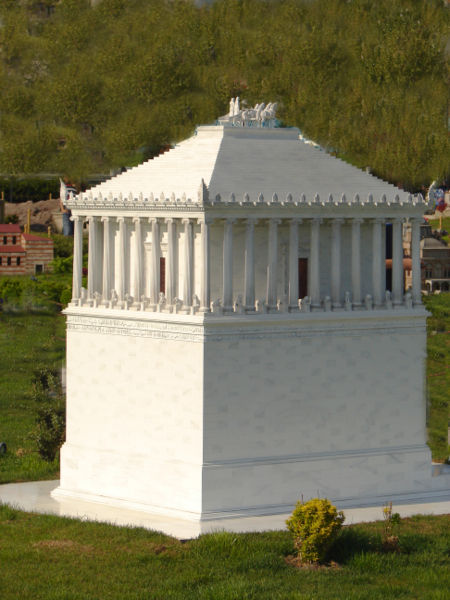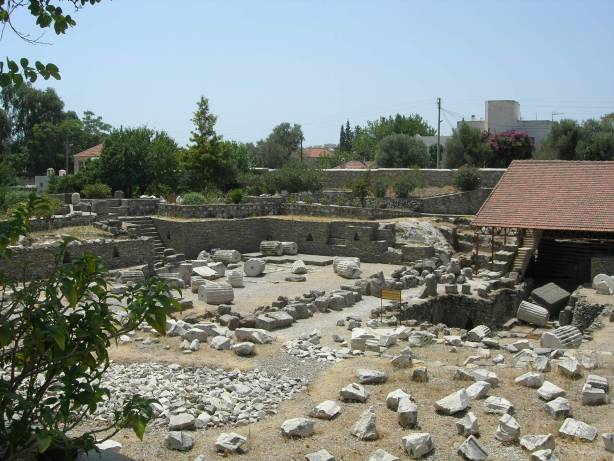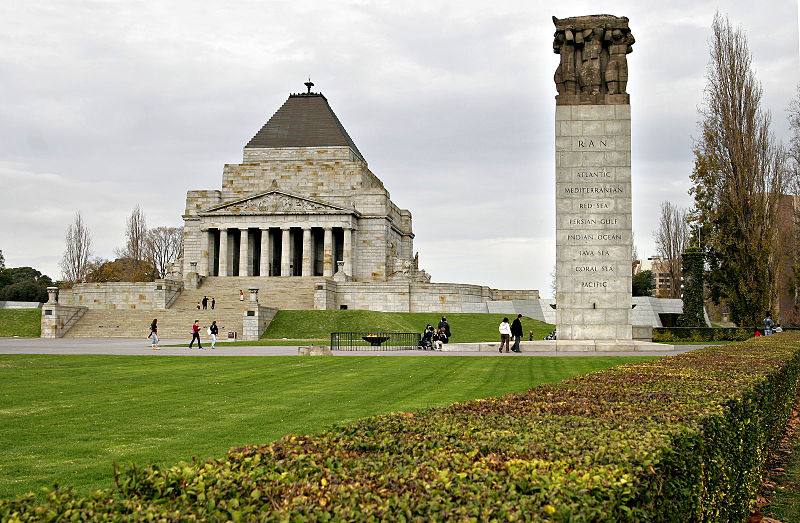<Back to Index>
- Halicarnassus, Turkey Tomb of Mausolus (Μαυσωλείον της Αλικαρνασσού), 350 B.C.
PAGE SPONSOR


The Mausoleum at Halicarnassus or Tomb of Mausolus (in Greek, Μαυσωλεῖον τῆς Ἁλικαρνασσοῦ) was a tomb built between 353 and 350 BC at Halicarnassus (present Bodrum, Turkey) for Mausolus, a satrap in the Persian Empire, and Artemisia II of Caria, his wife and sister. The structure was designed by the Greek architects Satyros and Pythius of Priene.
The Mausoleum stood approximately 45 m (148 ft) in height, and each of the four sides was adorned with sculptural reliefs created by each one of four Greek sculptors — Leochares, Bryaxis, Scopas of Paros and Timotheus. The finished structure was considered to be such an aesthetic triumph that Antipater of Sidon identified it as one of his Seven Wonders of the Ancient World.
The word mausoleum has now come to be used generically for any grand tomb.
In 623 BC, Halicarnassus was the capital of a small regional kingdom in the coast of Asia Minor. In 377 BC the ruler of the region, Hecatomnus of Milas,
died and left the control of the kingdom to his son, Mausolus.
Hecatomnus, a local satrap under the Persians, took control of several
of the neighboring cities and districts. After Artemisia and Mausolus,
he had several other daughters and sons: Ada (adopted mother of Alexander the Great), Idrieus and Pixodarus.
Mausolus extended its territory as far as the southwest coast of
Anatolia. Artemisia and Mausolus ruled from Halicarnassus over the
surrounding territory for twenty - four years. Mausolus, although
descended from local people, spoke Greek and admired the Greek way of
life and government. He founded many cities of Greek design along the
coast and encouraged Greek democratic traditions.
Mausolus decided to build a new capital; a city as safe from capture as it was magnificent to be seen. He chose the city of Halicarnassus. If Mausolus' ships blocked a small channel, they could keep all enemy warships out. His workmen deepened the city's harbor and used the dragged sand to make protecting breakwaters in front of the channel. On land they paved streets and squares, and built houses for ordinary citizens. And on one side of the harbor they built a massive fortified palace for Mausolus, positioned to have clear views out to sea and inland to the hills — places from where enemies could attack.
On land, the workmen also built walls and watchtowers, a Greek style theater and a temple to Ares — the Greek god of war.
Artemisia and Mausolus spent huge amounts of tax money to embellish the city. They commissioned statues, temples and buildings of gleaming marble. On a hill overlooking the city Artemisia planned to place a resting place for her body, and her husband's, after their death. It would be a tomb that would forever show how rich they were.
In 353 BC Mausolus died, leaving Artemisia to rule alone. As a tribute to him, she decided to build him a tomb so famous that Mausolus's name is now the eponym for all stately tombs, in the word mausoleum. The construction was also so beautiful and unique it became one of the Seven Wonders of the Ancient World.
Artemisia lived for only two years after the death of her husband. The urns with their ashes were placed in the yet unfinished tomb. As a form of sacrifice ritual the
bodies of a large number of dead animals were placed on the stairs
leading to the tomb, and then the stairs were filled with stones and
rubble, sealing the access. According to the historian Pliny the Elder, the craftsmen decided to stay and finish the work after the death of their patron "considering that it was at once a memorial of his own fame and of the sculptor's art."
Artemisia spared no expense in building the tomb. She sent messengers to Greece to find the most talented artists of the time. These included Scopas, the man who had supervised the rebuilding of the temple of Artemis at Ephesus. The famous sculptors were (in the Vitruvius order) Leochares, Bryaxis, Scopas and Timotheus, as well as hundreds of other craftsmen.
The tomb was erected on a hill overlooking the city. The whole structure sat in an enclosed courtyard. At the center of the courtyard was a stone platform on which the tomb sat. A stairway flanked by stone lions led to the top of the platform, which bore along its outer walls many statues of gods and goddess. At each corner, stone warriors mounted on horseback guarded the tomb. At the center of the platform, the marble tomb rose as a square tapering block to one - third of the Mausoleum's 45 m (148 ft) height. This section was covered with bas - reliefs showing action scenes, including the battle of the centaurs with the lapiths and Greeks in combat with the Amazons, a race of warrior women.
On
the top of this section of the tomb thirty - six slim columns, ten per
side, with each corner sharing one column between two sides; rose for
another third of the height. Standing between each [pair of] column[s]
was a statue. Behind the columns was a solid cella - like
block that carried the weight of the tomb's massive roof. The roof,
which comprised most of the final third of the height, was pyramidal. Perched on the top was a quadriga: four massive horses pulling a chariot in which rode images of Mausolus and Artemisia.
Modern historians have pointed out that two years would not be enough time to decorate and build such an extravagant building. Therefore, it is believed that construction was begun by Mausolus before his death or continued by the next leaders. The Mausoleum of Halicarnassus resembles a temple and the only way to tell the difference was its slightly higher outer walls. The Mausoleum was located in the Greek dominated area of Halicarnassus which in 353 was controlled by the Persian Empire. According to Roman Architect Vitruvius, it was built by Satyros and Pytheus who wrote a treatise about it, this treatise is now lost. Pausanias adds that the Romans considered the Mausoleum one of the great wonders of the world and it was for that reason that they called all their magnificent tombs mausolea, after it. It is unknown exactly when and how the Mausoleum came to ruin but according to Eustathius in the 12th century on his commentary of the Iliad; ”it was and is a wonder.” We are therefore led to believe that the building was likely ruined between this period and 1402 when the Knights of St. John arrived, likely by an earthquake.
In 1846 Lord Stratford de Redcliffe obtained permission to remove bassi - rilievi from the Budrum. This piece was originally part of the Mausoleum of Halicarnassus but was removed by St. Johns Knights. An expedition was sent by the British government after Mr. Charles Newton discovered the site where the mausoleum was located. This site was originally indicated by professor Donaldson. The expedition lasted 3 years and ended in the sending of the marbles.
All
that remained by the 19th century were the foundations and some broken
sculptures. Many of the stones from the mausoleum were sacked and used
by the Knights of St. John of Jerusalem to fortify their castle of
Bodrum. Much of the marble was burned into lime. The underground burial
chamber was broken into and destroyed by grave robbers; however in 1972
there was still enough remaining to create a layout of the chambers when
being excavated. This
monument was ranked the seventh wonder of the world by the ancients
themselves not because of its size or strength but because of the beauty
of its design and how it was decorated with sculpture or ornaments. The
mausoleum was Halicarnassus' principle architectural monument, standing
in a dominant position on rising ground above the harbor.”
Much of the information we have gathered about the Mausoleum and its structure have come from a Roman historian Pliny. He wrote some basic facts about the architecture and some dimensions. The building was rectangular, not square, surrounded by a colonnade of thirty - six columns. There was a pyramidal superstructure receding in twenty four steps to the summit. On top there were 4 horse chariots of marble. The building was accented with both sculptural friezes and free standing figures. "The free standing figures were arranged on 5 or 6 different levels.” We are now able to justify that Pliny’s knowledge came from a work written by the architect. It is clear that Pliny did not grasp the design of the mausoleum fully which creates problems in recreating the structure. However he does state many facts which help the reader recreate pieces of the puzzle. Other writings by Pausanias, Strabo, and Vitruvius also help us to gather more information about the Mausoleum. These Ancient authors describe the building's appearance and gave dimensions. According to Pliny the mausoleum was 63 ft. north and south, shorter on other fronts, 411 ft. circumference, and 25 cubics (37ft. 6 in.) in heights. It was surrounded by 36 columns. They called this part the pteron. Above the pteron there was a pyramid on top with 24 steps and equal in height to the lower part. The height of the whole work was 140 ft. The only other author that gives the dimensions of the Mausoleum is Hyginus a grammarian in the time of Augustus. He describes the monument as built with shining stones, 80ft high and 1340ft in circumference. He likely meant cubits which would match Pliny’s dimensions exactly but this text is largely considered corrupt and is of little importance. We learn from Vitruvius that Satyrus and Phytheus wrote a description of their work which Pliny likely read. Pliny likely wrote down these dimensions without thinking about the form of the building.
A
number of statues were found slightly larger than life size, either 5
ft. 0 in. or 5 ft. 3 in. in length these were 20 lion statues. Another
important find was the depth on the rock on which the building stood.
This rock was excavated to 8 or 9 ft. deep over and are 107 by 127 ft. The sculptors on the north were created by Scopas, the ones on the north
Bryaxis, on the south Timotheus and on the west Leochares. The Mausoleum was adorned with many great and beautiful sculptures. Some of
these sculptures have been lost or only fragments have been found.
Several of the statues' original placements are only known through
historical accounts. The great figures of Mausolus and Artemisia stood
in the chariot at the top of the top of the pyramid. The detached
equestrian groups are placed at the corners of the sub podium. The
semi - colossal female heads they may have belonged to the acroteria of
the two gables which may have represented the six Carian towns
incorporated in Halicarnassus. Work
still continues today as groups continue to excavate and research the
mausoleum’s priceless pieces of art. Many modern scholars and historians
discuss what it looked like. We can only hope that one day we will find
the missing physical piece and written documents outlining the history
of this great piece of architecture.
The Mausoleum overlooked the city of Halicarnassus for many years. It was untouched when the city fell to Alexander the Great in 334 BC and still undamaged after attacks by pirates in 62 and 58 BC. It stood above the city's ruins for sixteen centuries. Then a series of earthquakes shattered the columns and sent the bronze chariot crashing to the ground. By 1404 AD only the very base of the Mausoleum was still recognizable.
The Knights of St John of Malta invaded the region and built a massive castle called Bodrum Castle. When they decided to fortify it in 1494, they used the stones of the Mausoleum. In 1522 rumors of a Turkish invasion caused the Crusaders to strengthen the castle at Halicarnassus (which was by then known as Bodrum) and much of the remaining portions of the tomb were broken up and used in the castle walls. Sections of polished marble from the tomb can still be seen there today.
At this time a party of knights entered the base of the monument and discovered the room containing a great coffin. In many histories of the Mausoleum one can find the following story of what happened: The party, deciding it was too late to open it that day, returned the next morning to find the tomb, and any treasure it may have contained, plundered. The bodies of Mausolus and Artemisia were missing too. The small museum building next to the site of the Mausoleum tells the story. Research done by archeologists in the 1960s shows that long before the knights came, grave robbers had dug a tunnel under the grave chamber, stealing its contents. Also the museum states that it is most likely that Mausolus and Artemisia were cremated, so only an urn with their ashes was placed in the grave chamber. This explains why no bodies were found.
Before
grinding and burning much of the remaining sculpture of the Mausoleum
into lime for plaster, the Knights removed several of the best works and
mounted them in the Bodrum castle. There they stayed for three
centuries.
In the 19th century a British consul obtained several of the statues from the castle, which now reside in the British Museum. In 1852 the British Museum sent the archaeologist Charles Thomas Newton to search for more remains of the Mausoleum. He had a difficult job. He didn't know the exact location of the tomb, and the cost of buying up all the small parcels of land in the area to look for it would have been astronomical. Instead Newton studied the accounts of ancient writers like Pliny to obtain the approximate size and location of the memorial, then bought a plot of land in the most likely location. Digging down, Newton explored the surrounding area through tunnels he dug under the surrounding plots. He was able to locate some walls, a staircase, and finally three of the corners of the foundation. With this knowledge, Newton was able to determine which plots of land he needed to buy.
Newton then excavated the site and found sections of the reliefs that decorated the wall of the building and portions of the stepped roof. Also discovered was a broken stone chariot wheel some 2 m (6 ft 7 in) in diameter, which came from the sculpture on the Mausoleum's roof. Finally, he found the statues of Mausolus and Artemisia that had stood at the pinnacle of the building. In October 1857 Newton carried blocks of marble from this site by the HMS Supply and landed them in Malta. These blocks were used for the construction of a new dock in Malta for the Royal Navy. Today this dock is known at Dock No. 1 in Cospicua, but the building blocks are hidden from view, submerged in Dockyard Creek in the Grand Harbour.
From 1966 to 1977, the Mausoleum was thoroughly researched by Prof. Kristian Jeppesen of Aarhus University, Denmark. He has produced a six volume monograph, The Maussolleion at Halikarnassos.
The beauty of the Mausoleum was not only in the structure itself, but in the decorations and statues that adorned the outside at different levels on the podium and the roof: statues of people, lions, horses, and other animals in varying scales. The four Greek sculptors who carved the statues: Bryaxis, Leochares, Scopas and Timotheus were each responsible for one side. Because the statues were of people and animals, the Mausoleum holds a special place in history, as it was not dedicated to the gods of Ancient Greece.
Today, the massive castle of the Knights of Malta still stands in Bodrum, and the polished stone and marble blocks of the Mausoleum can be spotted built into the walls of the structure. At the site of the Mausoleum itself, only the foundation remains, together with a small museum. Some of the surviving sculptures at the British Museum include fragment of statues and many slabs of the frieze showing the battle between the Greeks and the Amazons. There the images of Mausolus and his queen forever watch over the few broken remains of the beautiful tomb she built for him.
Modern buildings based upon the Mausoleum of Mausolus include Grant's Tomb and 26 Broadway in New York City, Los Angeles City Hall, the Shrine of Remembrance in Melbourne, Australia, the spire of St. George's Church, Bloomsbury in London, the Indiana War Memorial (and in turn Chase Tower) in Indianapolis, the Ancient Accepted Scottish Rite Southern Jurisdiction's headquarters, the House of the Temple in Washington D.C., the Civil Courts Building in St. Louis, and the Soldiers and Sailors Memorial in Pittsburgh.

